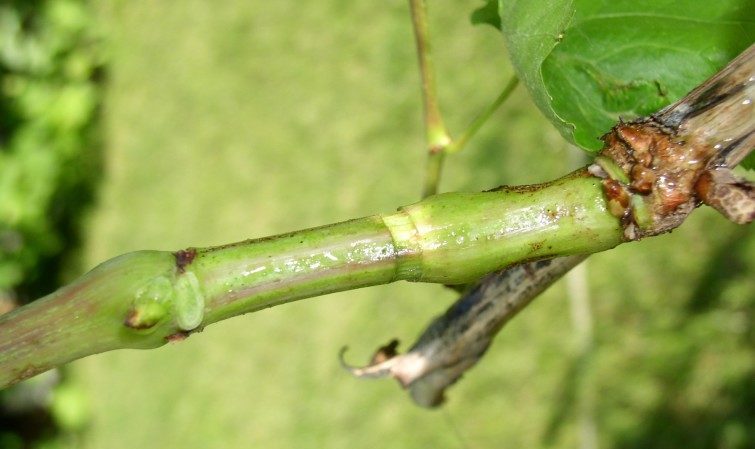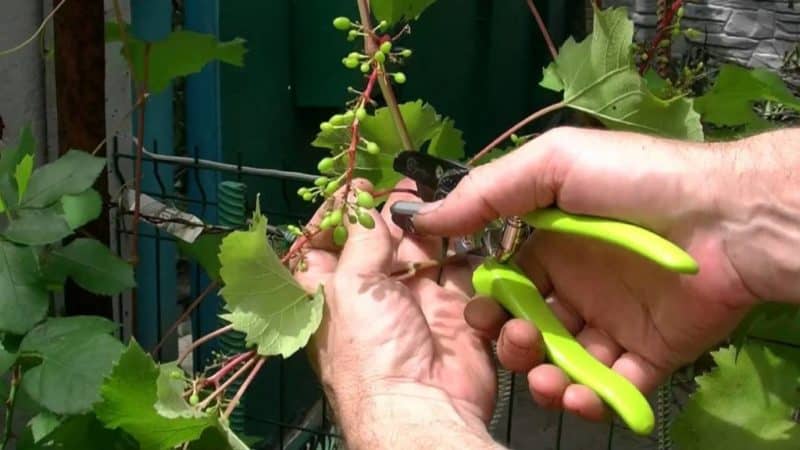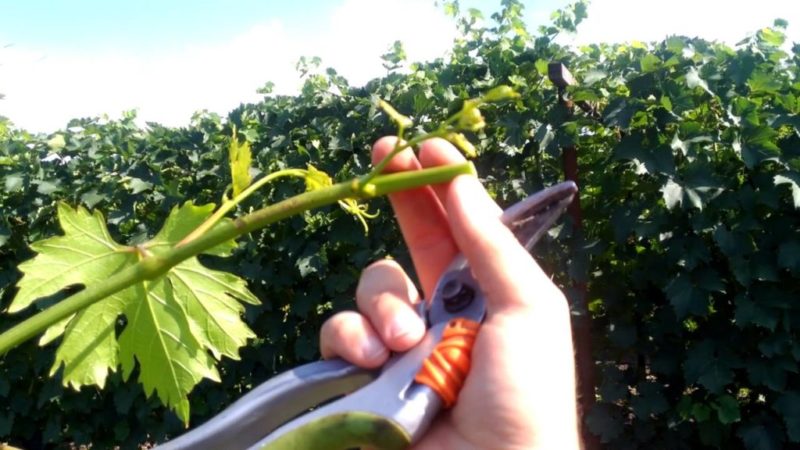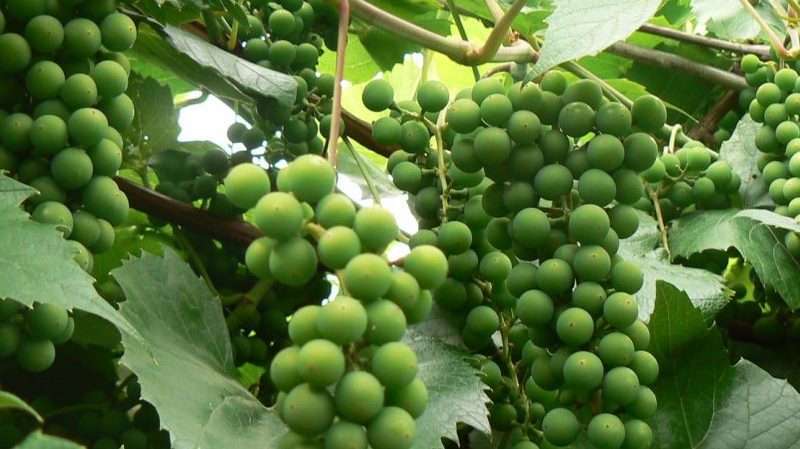Is it possible to speed up the ripening of grapes in August and how to do it
Growing grapes is becoming an increasingly popular activity: thanks to the efforts of breeders, this southern crop is taking root even in Siberia. Grapes are an easy plant to cultivate, but their cultivation requires certain knowledge. It happens that due to a late spring with frosts or a cool summer, the berries take a long time to ripen. We'll tell you how to speed up the ripening of grapes in August.
Is it possible to speed up ripening?

Using simple agrotechnical techniques, you will be able to harvest ripe tassels 1-2 weeks earlier.
The use of measures to accelerate the ripening of grapes is justified in the following cases:
- the fruits are in no hurry to ripen due to the vagaries of the weather (late spring and cold summer);
- when grown for the purpose of sale: early grapes are more expensive and are sold out quickly;
- I want to enjoy sweet berries early.
It is important to accelerate ripening correctly, otherwise you may lose the harvest altogether.
Methods to accelerate maturation
There are many methods for accelerating the ripening of grape fruits of various varieties.
We’ll tell you in more detail what to do to make the grapes ripen faster and be larger.
Banding

The essence of this method is to artificially stop the outflow of organic substances produced by leaves into the root system and perennial parts of the bush. After ringing, the plant juices and the minerals they contain more actively nourish the bunches, accelerating the onset of ripeness.
On a note! Banding is used to accelerate ripening and increase yield. Depending on the purpose, the procedure is carried out at different times.
If the purpose of the procedure is to increase the number of berries in the bunches, it is carried out before flowering. To increase the size of the fruit - after flowering, and to speed up ripening - when the berries are formed and filled.
For banding, make 2 circular cuts on the bark with a sharp knife every 3–5 mm, and peel off a thin strip of bark between the cuts. Such a wound does not heal for a long time and interferes with the flow of sap. Some winegrowers use wire: they wind it tightly in several turns at the base of the fruit shoot after flowering has ended.
To speed up ripening, ringing is not carried out on young grape bushes, shoots and replacement knots, since ringed vines are not left for fruiting next year.
Carrying out this procedure every year leads to the death of the bushes, since the accumulation of nutrients by the plant is disrupted, which leads to its depletion. Therefore, ringing is carried out only if necessary on individual fruit shoots.
Rationing

It happens that the weather is pleasant and vineyard care correct, but the berries are still in no hurry to sing. The reason for slow ripening often lies in overloading the bush. Beginner gardeners often make this mistake in pursuit of large yields.
Attention! Rationing is a simple and effective method that involves removing excess bunches.
As a rule, 2 bunches are left on each vine at the beginning of summer. If the ripening of berries is delayed, those clusters that are located higher on the vine are removed.If each shoot already has one bunch, the smallest and most underdeveloped ones are removed.
It is advisable to thin out the berries in the bunches themselves. First of all, underdeveloped and spoiled specimens are plucked out, as well as those that grow in the middle of the hand. In this case, no more than 20% of the total mass of berries is cut out.
Stepsoning

Removing grape shoots involves completely or partially breaking out young shoots. Pinching is carried out to limit the growth of new shoots and direct all the forces of the bush to the ripening of the vines and bunches.
Reference! Stepchildren are shoots emerging from buds in the axils of the leaves.
Stepping of bushes begins in the spring by cutting out small shoots at the initial stage of their growth and continues throughout the season as new stepsons appear.
Thinning
Regular pruning of bushes, including their thinning, is an important stage. Secondary shoots not only slow down the rate of berry ripening, but also lead to thickening of the vineyard and insufficient ventilation of the bushes. This leads to the development of diseases.
Removing leaves
Removing excess foliage is another effective way to speed up the ripening of berries. The point of the procedure is to open the bunches to the sun's rays.
When thinning, be sure to pull out all the weeds and remove the lower leaves that cover the bunches from the sun.
Chasing shoots

The minting of grape shoots is carried out at the moment the berries begin to ripen. The point of this method is to remove the tips of the shoots, which are actively growing and taking nutrition from the ripening bunches. To do this, use pruning shears to cut off the upper part of the shoot down to the first developed leaf.
Despite the seeming logic of this method, some winegrowers consider this approach to be incorrect, arguing that pinching the main shoots provokes the growth of stepchildren, which ultimately take even more nutrition.
Increase in temperature near the bushes
This method is especially effective when growing crops in the Urals and in Siberia, where cool summers often delay harvesting. The purpose of the procedure is to provide warmth to the lower part of the bushes, which accelerates the ripening of the bunches.
The root system is effectively protected from the cold by a layer of mulch. It is good to place large flat stones, concrete tiles or water bottles under the bushes. During the day they will heat up, and at night they will give off heat. On especially cold nights, the bushes are covered with agrofibre, throwing it over a trellis.
Twisting grapes
This technique consists of turning 180° bunches of almost ripened grapes, which only have to gain sugars. After this procedure, nutritious juices stop flowing to the berries, and water evaporates through the skin. Because of this, the concentration of sugars in fruits increases.
However, in some cases, the use of this technique leads to withering of the berries and loss of taste, or the brushes are completely torn off the vine. The stalks are especially fragile after rains. Therefore, twisting is used with caution, first turning the brushes 60–90°.
Application of fertilizers

To accelerate ripening, it is important to treat the vineyard with fertilizers. Knowing what feed the bushes before and during the ovary, it will be possible to get the harvest a couple of weeks earlier.
Attention! How to treat grapes for faster ripening? Potassium is especially important for ripening berries. feeding. It is potassium that stimulates the outflow of nutrients from the leaves to the bunches and promotes the accumulation of sugars in the fruits.
Potassium fertilizing is carried out along the leaves and under the roots. They use both industrial fertilizers - potassium magnesia, potassium sulfate, potassium monophosphate (the drugs are used according to the instructions on the packaging), and folk remedies - wood ash, extracts and infusions based on it.
Fertilizers with potassium are applied 2 times: 2 weeks before the grapes begin to set, and 2 weeks before harvest.
Another substance that accelerates the ripening of grapes is phosphorus. Products based on it are applied 1-2 weeks before flowering.
Stopping irrigation
This is the simplest of the listed ways to accelerate maturation. Watering is stopped from mid-July. Excess moisture only delays the ripening of berries.
Lack of competitors
The absence of competitors for food guarantees the bushes a full supply of all nutrients, timely filling and ripening of berries. It is not recommended to plant young grapes and other garden crops under a fruit-bearing bush.
It is important to choose a suitable location for the vineyard. In the full sun and areas open to light and air, the clusters will ripen faster.
Features of accelerating maturation for different regions of Russia

The listed methods for accelerating ripening are used and combined depending on the climatic conditions of the cultivation region.
When growing in the Urals and Siberia, it is important to insulate the root system and ground parts of the bushes on cool nights in August and September. For the same purpose, the bushes are watered only with warm water.
It is imperative to pick off the leaves in the fruiting zone, otherwise the bunches simply won’t have enough sun to ripen.
When growing grapes in the Moscow region and central Russia, chasing shoots from August 20 is common. This technique allows you to restrain the growth of the vegetative mass and direct all the forces of the crop to ripening the berries.
For different grape varieties
Light varieties in the sun they acquire a characteristic golden color. For them, the foliage is torn off above the clusters, exposing the berries to the sun. For dark grape varieties, the foliage around the bunches is removed to improve air exchange inside the bush.
Late varieties of grapes (Biruintsa, Italy, Ataman, etc.) require thinning of the foliage in the fruiting zone to accelerate ripening. This is especially important if autumn turns out to be cool and rainy.
Advice from experienced winegrowers
Advice from experienced winegrowers will help novice gardeners avoid mistakes when growing sunny berries:
- Careful approach to variety selection. By choosing proven zoned varieties, you will receive a guaranteed harvest and trouble-free wintering of the vines even in Siberia. For beginning winegrowers, unpretentious varieties such as Aleshenkin, Beauty of the North, Zagadka Sharova, and Cosmonaut are suitable. They produce small and medium-sized, but tasty berries.
- Correct choice of location and its preparation. An unsuitable place will negate all efforts and remove the desire to grow grapes further. The plot is suitable sunny, protected from northern winds, with a calm southern slope.
- Protection of plantings from diseases and pests. In spring and summer, grapes are treated against mildew, oidium, gray rot and other diseases. Protection against pests that can cause significant damage to the crop is important.
- A balanced approach to fertilization.The use of excessive amounts of organic and mineral fertilizers in planting holes causes burns or death of young roots. Therefore, such funds are applied in strict accordance with the instructions.
- Improving soil structure. To improve the breathability of the soil, sand and straw are used. Manure is used with caution, as it is rich in nitrogen, which stimulates rapid growth of green mass. To ensure that the vines ripen before autumn, the grapes are fertilized with manure only in the spring.
Conclusion
Sometimes winegrowers experience delayed berry ripening. The weather in August and September is no longer what it was in the summer: frequent rains and temperature changes can negate all the gardener’s efforts. In such cases, special techniques are used to accelerate the ripening of bunches and improve the quality of the fruit.
where did you rip it off?